Pongo pygmaeus, Pongo abelii, and Pongo tapanuliensis
Orangutan
Orangutan
Pongo pygmaeus, Pongo abelii, and Pongo tapanuliensis
Orangutans are among the most intelligent primates. They use a variety of sophisticated tools and construct elaborate sleeping nests each night from branches and foliage. The apes’ learning abilities have been studied extensively. There may be distinctive cultures within populations. Orangutans have been featured in literature and art since at least the 18th century, particularly in works which comment on human society. Field studies of the apes were pioneered by primatologist Birutė Galdikas and they have been kept in captive facilities around the world since at least the early 19th century. All three orangutan species are considered critically endangered. Human activities have caused severe declines in populations and ranges. Threats to wild orangutan populations include poaching, habitat destruction because of palm oil cultivation, and the illegal pet trade. Several conservation and rehabilitation organisations are dedicated to the survival of orangutans in the wild.
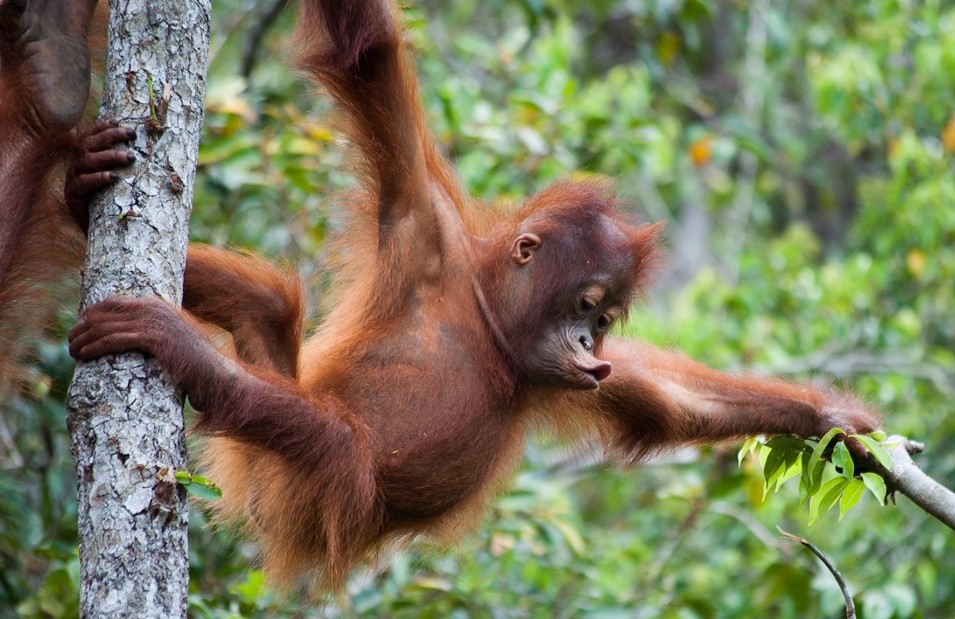 Characteristics
Characteristics
Orangutans display significant sexual dimorphism; females typically stand 115 cm (3 ft 9 in) tall and weigh around 37 kg (82 lb), while flanged adult males stand 137 cm (4 ft 6 in) tall and weigh 75 kg (165 lb). Compared to humans, they have proportionally long arms, a male orangutan having an arm span of about 2 m (6.6 ft), and short legs.
Most of their bodies are covered in coarse hair that is generally red but ranges from bright orange to maroon or dark chocolate, while the skin is grey-black. Though largely hairless, males’ faces can develop some hair, giving them a beard.
Orangutans have small ears and noses; the ears are unlobed. The mean endocranial volume is 397 cm3. The braincase is elevated relative to the facial area, which is concave and prognathous. Compared to chimpanzees and gorillas, the brow ridge of an orangutan is underdeveloped. Females and juveniles have rounded skulls and narrow faces while males develop a large sagittal crest and large cheek pads or flanges, which show their dominance to other males. The cheek pads are made mostly of fatty tissue and are supported by the musculature of the face. Mature males also develop large throat pouches and long canines.
 Orangutan hands have four long fingers but a dramatically shorter opposable thumb for a strong grip on branches as they travel high in the trees. The resting configuration of the fingers is curved, creating a suspensory hook grip. With the thumb out of the way, the fingers (and hands) can grip securely around objects with a small diameter by resting the tops of the fingers against the inside of the palm, thus creating a double-locked grip.
Orangutan hands have four long fingers but a dramatically shorter opposable thumb for a strong grip on branches as they travel high in the trees. The resting configuration of the fingers is curved, creating a suspensory hook grip. With the thumb out of the way, the fingers (and hands) can grip securely around objects with a small diameter by resting the tops of the fingers against the inside of the palm, thus creating a double-locked grip.
Their feet have four long toes and an opposable big toe, enabling orangutans to grasp things securely both with their hands and with their feet. Since their hip joints have the same flexibility as their shoulder and arm joints, orangutans have less restriction in the movements of their legs than humans have.
Orangutans move through the trees by both vertical climbing and suspension. Compared to other great apes, they infrequently descend to the ground where they are more cumbersome. Unlike gorillas and chimpanzees, orangutans are not true knuckle-walkers; a form of terrestrial locomotion which involves the use a more relaxed open hand with the middle segments of the fingers sweeping the ground and the feet flat. Orangutans tuck in their digits and shuffle on the sides of their hands and feet.
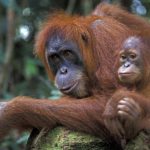
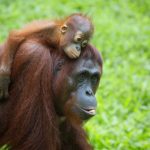
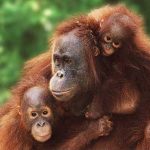
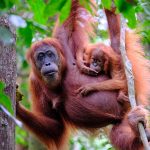

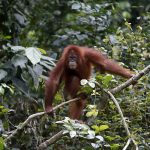
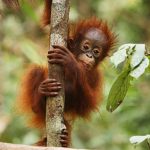
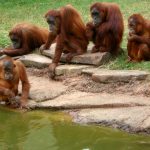
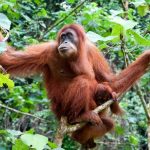
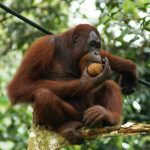
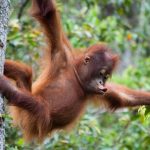
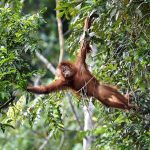
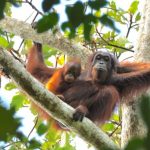
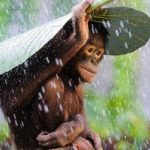
 Compared to their relatives in Borneo, Sumatran orangutans are thinner with paler and longer hair and a longer face. Tapanuli orangutans resemble Sumatran orangutans more than Bornean orangutans in body build and fur colour. They have frizzier hair, smaller heads, and flatter and wider faces than the other species.
Compared to their relatives in Borneo, Sumatran orangutans are thinner with paler and longer hair and a longer face. Tapanuli orangutans resemble Sumatran orangutans more than Bornean orangutans in body build and fur colour. They have frizzier hair, smaller heads, and flatter and wider faces than the other species.
Ecology and behaviour
Orangutans are mainly arboreal and inhabit tropical rainforest, particularly lowland dipterocarp and old secondary forest. Population densities are highest in habitats near rivers, such as freshwater and peat swamp forest, while drier forests away from the flood plains are less inhabited. Population density also decreases at higher elevations. Orangutans occasionally enter grasslands, cultivated fields, gardens, young secondary forest, and shallow lakes.
Most of the day is spent feeding, resting, and travelling. They start the day feeding for two to three hours in the morning. They rest during midday, then travel in the late afternoon. When evening arrives, they prepare their nests for the night. Potential predators of orangutans include tigers, clouded leopards and wild dogs. The absence of tigers on Borneo has been suggested as a reason Bornean orangutans are found on the ground more often than their Sumatran relatives. The most frequent orangutan parasites are nematodes of the genus Strongyloides and the ciliate Balantidium coli. Among Strongyloides, the species S. fuelleborni and S. stercoralis are commonly reported in young individuals. Orangutans also use the plant species Dracaena cantleyi as an anti-inflammatory balm.
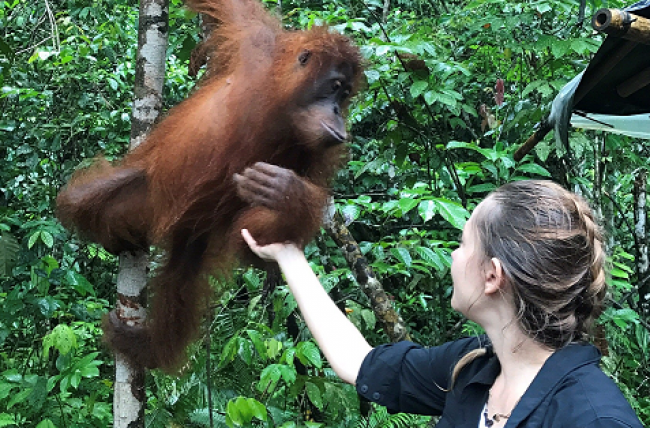 Diet and feeding
Diet and feeding
Orangutans are primarily frugivores (fruit-eaters) and 57–80% of their feeding time is spent foraging for fruits. Even during times of scarcity, fruit can still take up 16% of feeding. Orangutans prefer fruits with soft pulp, arils or seed-walls surrounding their seeds, as well as trees with large crops. Figs fit both preferences and are thus highly favoured, but they also consume drupes and berries. Orangutans are thought to be the sole fruit disperser for some plant species including the vine species Strychnos ignatii which contains the toxic alkaloid strychnine.
Orangutans also supplement their diet with leaves, which take up 25% of their foraging time on average. Leaf eating increases when fruit gets scarcer, but even during times of fruit abundance, orangutan will eat leaves 11–20% of the time. The leaf and stem material of Borassodendron borneensis appears to be an important food source during low fruit abundance. Other food items consumed by the apes include bark, honey, bird eggs, insects and small vertebrates including the slow loris.
In some areas, orangutans may practice geophagy, which involves consuming soil and other earth substances. The apes may eat tubes of soil created by termites along tree trunks as well as descend to the ground to uproot soil to eat. Orangutans are also known to visit mineral licks at the clay or sandstone-like walls of cliffs or earth depressions. Soils appear to contain a high concentration of kaolin, which counteracts toxic tannins and phenolic acids found in the orangutan’s diet.
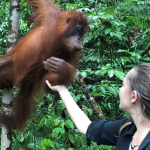
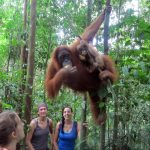
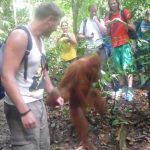
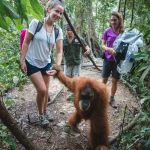
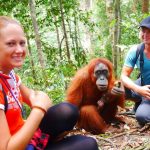
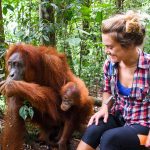
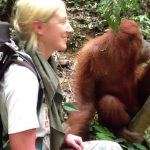
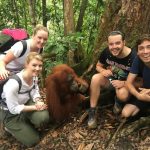
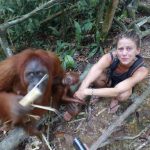
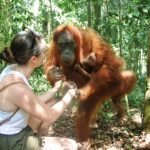
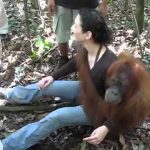
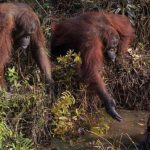

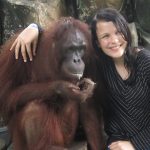
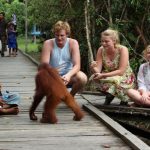


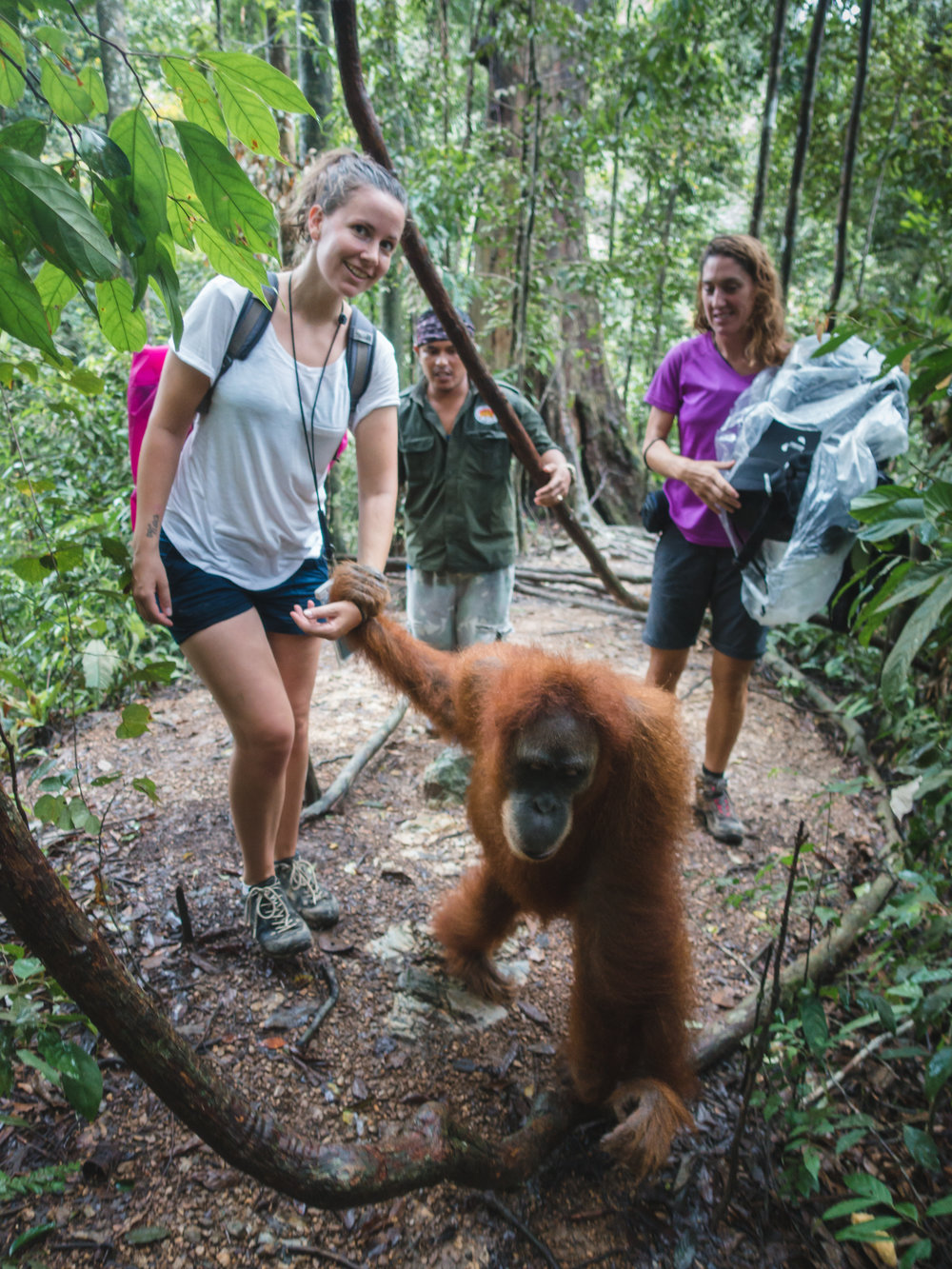 Social life
Social life
The social structure of the orangutan can be best described as solitary but social; they live a more solitary lifestyle than the other great apes. Bornean orangutans are generally more solitary than Sumatran orangutans. Most social bonds occur between adult females and their dependent and weaned offspring. Resident females live with their offspring in defined home ranges that overlap with those of other adult females, which may be their immediate relatives.
 One to several resident female home ranges are encompassed within the home range of a resident male, who is their main mating partner. Interactions between adult females range from friendly to avoidance to antagonistic.
One to several resident female home ranges are encompassed within the home range of a resident male, who is their main mating partner. Interactions between adult females range from friendly to avoidance to antagonistic.
The home ranges of resident males can overlap greatly, though encounters are relatively rare and hostile. Adult males are dominant over sub-adult males, the latter of which keep their distance.
Orangutans disperse and establish their home ranges by age 11. Females tend to settle close to their mothers, while males disperse much farther but may include their natal (birth) range within their new home range. They enter a transient phase, which lasts until a male can challenge and displace a dominant, resident male from his home range.
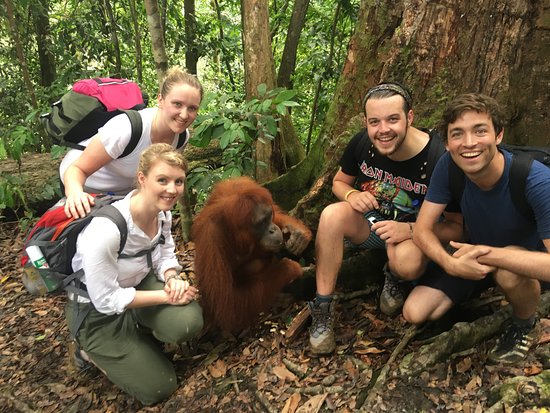 Both resident and transient orangutans aggregate on large fruiting trees to feed. The fruits tend to be abundant, so competition is low and individuals may engage in social interactions. Orangutans will also form travelling groups with members moving between different food sources. They are often consortships between an adult male and a female. Social grooming is uncommon among orangutans.
Both resident and transient orangutans aggregate on large fruiting trees to feed. The fruits tend to be abundant, so competition is low and individuals may engage in social interactions. Orangutans will also form travelling groups with members moving between different food sources. They are often consortships between an adult male and a female. Social grooming is uncommon among orangutans.
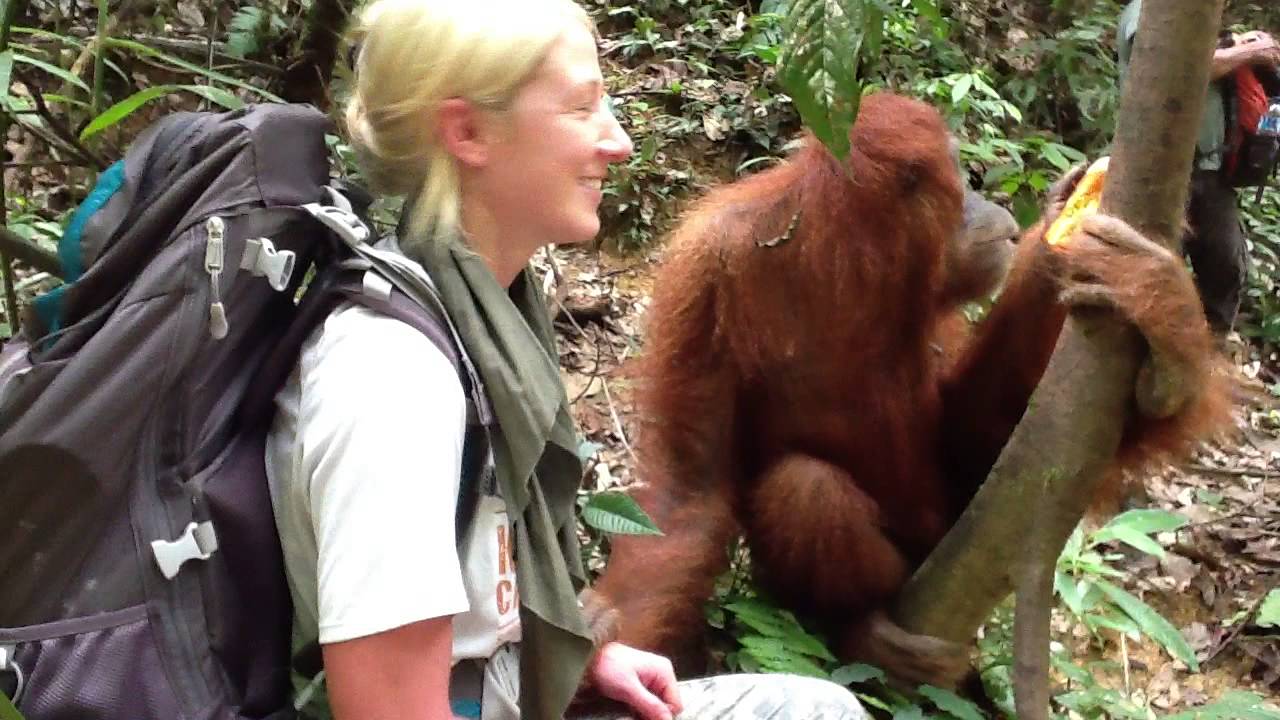 Orangutans communicate with various sounds. Males will make long calls, both to attract females and to advertise themselves to other males. These are divided into three parts; they begin with grumbles, climax with pulses and end with bubbles.
Orangutans communicate with various sounds. Males will make long calls, both to attract females and to advertise themselves to other males. These are divided into three parts; they begin with grumbles, climax with pulses and end with bubbles.
Both sexes will try to intimidate conspecifics with a series of low guttural noises known collectively as the “rolling call”. When annoyed, an orangutan will suck in air through pursed lips, making a kissing sound known as the “kiss squeak”. Mothers produce throatscrapes to keep in contact with their offspring. Infants make soft hoots when distressed. Orangutans are also known to produce smacks or blow raspberries when making a nest.
